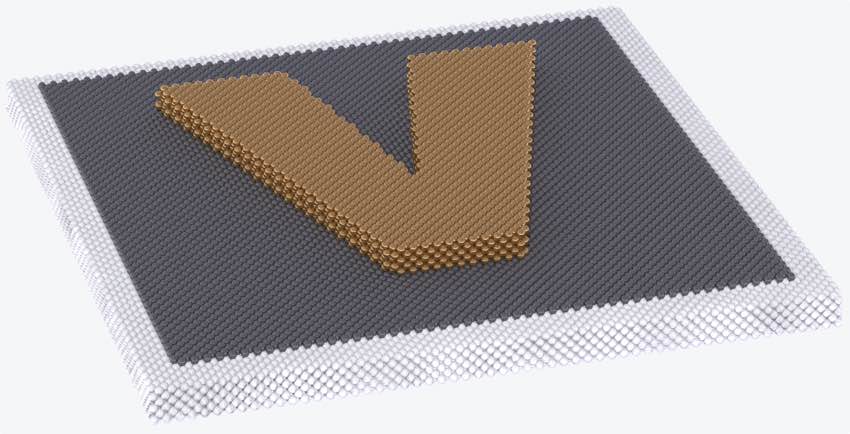
vampire is a powerful software package, capable of simulating many different systems and the determination of parameters such as coercivity, Curie and N'eel temperatures, reversal dynamics, statistical behaviour and more.
Feature Overview
The features of the \vampire code are split into three main categories: material parameters, structural parameters, and simulation parameters. Details of these parameters are given in the following lines:
Materials
Material parameters essentially define the magnetic properties of a class of atoms, including magnetic moments, exchange interactions, damping constants etc. \vampire includes support for up to one hundred defined materials, and material parameters control the simulation of multilayers, random alloys, core shell particles and lithographically defined patterns.
Structures
Structural parameters define properties such as the system size, shape, particle size, or voronoi grain structures. In combination with material parameters they essentially define the system to be simulated.
Simulations
vampire includes a number of built-in simulations for determining the most common magnetic properties of a system, for example Curie temperature, hysteresis loops, or even a time series. Additionally the parameters for these simulations, such as applied field, maximum temperature, temperature increment, etc. can be set.
Input and Output Files
vampire requires at least two files to run a simulation, the input file and the material file. The input file defines all the properties of the simulated system, such as the dimensions or particle shape, as well as the simulation parameters and program output. The material file defines the properties of all the materials used in the simulation, and is usually given the mat file extension. A sample material file Co.mat is included with the code which defines a minimum set of parameters for Co.
The output of the code includes a main output file, which records data such as the magnetisation, timesteps, temperature etc. The format of the output file is fully customisable, so that the amount of output data is limited to what is useful. In addition to the output file, the other main available outputs are spin configuration files, which with post-processing allow output of snapshots of the magnetic configurations during the simulation.
Sample input files
Sample input and output files are included in the source code distribution, but the files for a simple test simulation which computes the time dependence of the magnetisation of a cubic system are given here.
input
#------------------------------------------
# Sample vampire input file to perform
# benchmark calculation for version 5.0
#
#------------------------------------------
#------------------------------------------
# Creation attributes:
#------------------------------------------
create:crystal-structure = sc
#------------------------------------------
# System Dimensions:
#------------------------------------------
dimensions:unit-cell-size = 3.54 !A
dimensions:system-size-x = 7.7 !nm
dimensions:system-size-y = 7.7 !nm
dimensions:system-size-z = 7.7 !nm
#------------------------------------------
# Material Files:
#------------------------------------------
material:file = Co.mat
#------------------------------------------
# Simulation attributes:
#------------------------------------------
sim:temperature = 300.0
sim:time-steps-increment = 1000
sim:total-time-steps = 10000
sim:time-step = 1 !fs
#------------------------------------------
# Program and integrator details
#------------------------------------------
sim:program = benchmark
sim:integrator = llg-heun
#------------------------------------------
# data output
#------------------------------------------
output:real-time
output:temperature
output:magnetisation
output:magnetisation-length
screen:time-steps
screen:magnetisation-length
Co.mat
#===================================================
# Sample vampire material file version 5
#===================================================
#---------------------------------------------------
# Number of Materials
#---------------------------------------------------
material:num-materials=1
#---------------------------------------------------
# Material 1 Cobalt Generic
#---------------------------------------------------
material[1]:material-name = Co
material[1]:damping-constant = 1.0
material[1]:exchange-matrix[1] = 11.2e-21
material[1]:atomic-spin-moment = 1.72 !muB
material[1]:uniaxial-anisotropy-constant = 1.0e-24
material[1]:material-element = Ag
material[1]:minimum-height = 0.0
material[1]:maximum-height = 1.0
Calculation
/vampire-tutorials/Co> vampire-serial
_
(_)
__ ____ _ _ __ ___ _ __ _ _ __ ___
\ \ / / _` | '_ ` _ \| '_ \| | '__/ _ \
\ V / (_| | | | | | | |_) | | | | __/
\_/ \__,_|_| |_| |_| .__/|_|_| \___|
| |
|_|
Version 6.0.0 Apr 26 2022 23:42:26
Git commit:
Licensed under the GNU Public License(v2). See licence file for details.
Lead Developer: Richard F L Evans <richard.evans@york.ac.uk>
Contributors: Sarah Jenkins, Andrea Meo, Andrew Naden, Matthew Ellis,
Oscar Arbelaez, Sam Morris, Rory Pond, Weijia Fan,
Phanwadee Chureemart, Pawel Sobieszczyk, Joe Barker,
Thomas Ostler, Andreas Biternas, Roy W Chantrell,
Wu Hong-Ye, Razvan Ababei, Sam Westmoreland,
Daniel Meilak
Compiled with: GNU C++ Compiler
Compiler Flags:
Vampire includes a copy of the qhull library from C.B. Barber and The
Geometry Center and may be obtained via http from www.qhull.org.
================================================================================
Fri May 6 00:09:30 2022
================================================================================
Initialising system variables
Creating system
Generating neighbour list..........done!
Copying system data to optimised data structures.
Using generic/normalised form of exchange interaction with 6 total interactions.
Number of atoms generated: 10648
Starting Simulation with Program Benchmark...
1000 0.887306
2000 0.888853
3000 0.897749
4000 0.890028
5000 0.889241
6000 0.893616
7000 0.890793
8000 0.890163
9000 0.887654
10000 0.892783
Simulation run time [s]: 19.6266
Simulation ended gracefully.
The content of the output file
#----------------------------------------------------------------------------------------------------------------------------------------------------------
# Output file for vampire simulation
# time : 2022-05-06 00:09:31 process id : 3775
# hostname : linux-kq57
# path : /home/algerien/abinitio/vampire-tutorials/Co
# version : 6.0.0
# githash :
#----------------------------------------------------------------------------------------------------------------------------------------------------------
1e-12 0.115414 -0.00861624 0.99328 0.887306
2e-12 0.2 -0.035775 0.979143 0.888853
3e-12 0.156644 -0.0751085 0.984795 0.897749
4e-12 0.195622 -0.131047 0.971884 0.890028
5e-12 0.336083 -0.0791647 0.938499 0.889241
6e-12 0.29656 -0.0194227 0.954817 0.893616
7e-12 0.261457 -0.162865 0.951375 0.890793
8e-12 0.203677 -0.220226 0.953948 0.890163
9e-12 0.270237 -0.293326 0.917023 0.887654
1e-11 0.274289 -0.22906 0.933969 0.892783
Reference: https://vampire.york.ac.uk/resources/vampire-manual.pdf


0 Comments